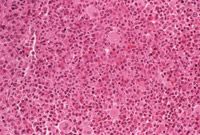Imatinib-like agents on way to treat CML
Small signs of resistance to imatinib (Gleevec, Novartis) emerged soon after the drug's approval in 2001 as the first oral tyrosine kinase inhibitor for chronic myeloid leukemia (CML). But second-generation drugs with similar mechanisms of action were already in the pipeline, according to studies presented at the recent 2005 ASH annual meeting, held in Atlanta. Generally about 20% of CML chronic-phase patients relapse after three years of imatinib therapy, researchers pointed out.
Small signs of resistance to imatinib (Gleevec, Novartis) emerged soon after the drug's approval in 2001 as the first oral tyrosine kinase inhibitor for chronic myeloid leukemia (CML). But second-generation drugs with similar mechanisms of action were already in the pipeline, according to studies presented at the recent 2005 ASH annual meeting, held in Atlanta. Generally about 20% of CML chronic-phase patients relapse after three years of imatinib therapy, researchers pointed out.
Dasatinib (BMS-354825, Bristol-Myers Squibb) is a novel, oral, multitargeted kinase inhibitor that focuses on the chromosomal mutations in CML that lead to disease progression. Many experts call it the most promising of the new imatinib-like agents.

"This is very encouraging news for patients, and it should be viewed as a step forward in CML treatment," commented lead investigator Andreas Hochhaus, University of Heidelberg, Mannheim, Germany.
The ASH meeting featured another agent-AMN107 (Novartis), which is 10 to 50 times more potent than imatinib. In a phase I clinical trial, 119 patients who were resistant to imatinib received AMN107; in some cases the dose was increased up to 12-fold with no problems.
"The range of response to AMN107 varied, depending on the form of the cancer and the presence of genetic mutations," reported the study's lead author Hagop Kantarjian, M.D., professor and chair of the department of leukemia, M. D. Anderson Cancer Center, University of Texas. "For example, among CML patients who harbored the cancerous mutation BCR-ABL before treatment, 60% achieved a hematologic response and 41% a cytogenetic response." The results suggest that physicians will be able to tailor leukemia therapy, "offering different treatments for subsets of patients based on their cancer's molecular signature," he added. "AMN107 looks like an option for patients who do not have a good response to Gleevec therapy."
In other treatment news from the ASH meeting:
Interim long-term follow-up data-up to 48 weeks-show the new targeted drug AMG-531 continuing to safely stimulate platelet production in patients with immune thrombocytopenic purpura (ITP). Overall, 85% of patients in an open-label study (29 of 34) achieved a platelet response, i.e., doubling the baseline platelet count and at least 50,000 platelets per microliter of blood.
"ITP is a chronic, autoimmune bleeding disorder characterized by low levels of platelets in the blood," explained lead author James B. Bussell, M.D., professor of pediatrics and medicine, Weill Cornell Medical Center, New York. "Some 200,000 Americans, mostly women, have the disease. It's exciting that most patients in this study achieved platelet counts of more than 50,000 per microliter, from a starting count of about 18,000," he pointed out. "This suggests that AMG-531 may stimulate production of platelets faster than the immune system can destroy them."
The Food & Drug Administration has granted the drug fast-track designation "to address a serious unmet medical need," according to the manufacturer, Amgen. Traditional treatments of ITP-primarily corticosteroid use and splenectomy-decrease platelet destruction by suppressing the immune system. But side effects are numerous, and half of patients do not respond at all.